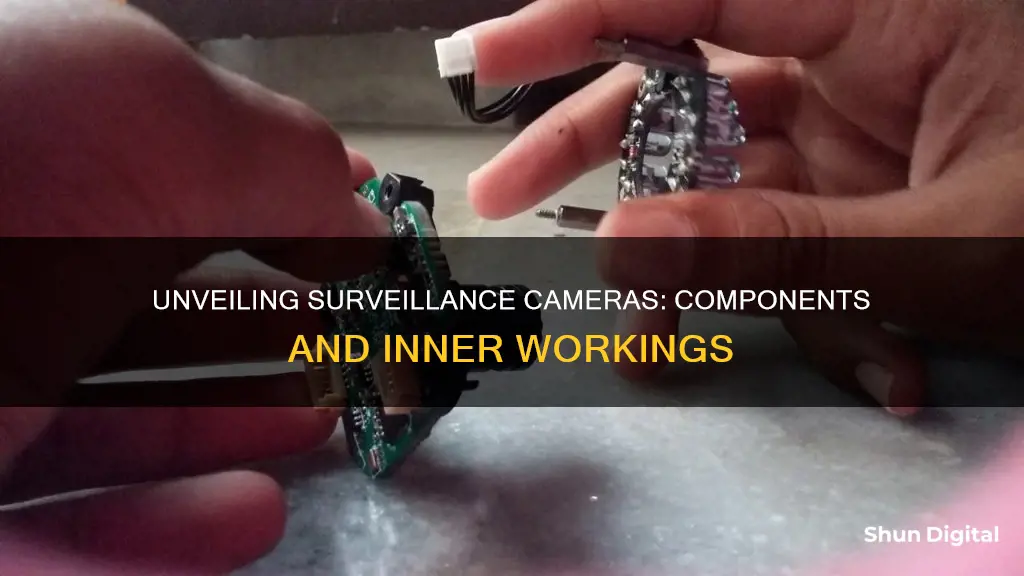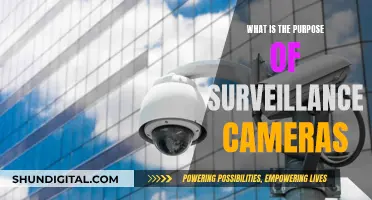
Surveillance cameras, also known as closed-circuit television (CCTV), are video cameras used to monitor behaviour and activity for the purpose of information gathering, crime prevention, and criminal investigation. They are often connected to a recording device or IP network and may be watched by security guards or law enforcement officers. Surveillance cameras can be installed in plain sight or hidden from view, and can be used both indoors and outdoors. They are commonly used in public spaces, residential areas, commercial buildings, and industrial plants.
The technology used in surveillance cameras has evolved over time, with recent advancements in internet-based products, artificial intelligence, and wireless connectivity. Surveillance cameras can have features such as high-resolution imaging, night vision capabilities, remote access and control, and integration with other systems. They can also be equipped with motion sensors, which record only when motion is detected, reducing the amount of footage.
Surveillance cameras have been the subject of debate due to concerns about privacy and civil liberties. While they can be effective in deterring and solving crimes, there are questions about the extent of their use and the potential for misuse.
| Characteristics | Values |
|---|---|
| Purpose | Deterring improper behaviour, monitoring, recording movement, gathering information, influencing, managing, directing |
| Camera Type | Analog, digital, IP, wireless, wired |
| Camera Placement | Inside or outside a building, in plain sight, hidden |
| Camera Features | Resolution, frame rate, colour type, night vision, remote access, AI-powered analytics |
| Recording Features | DVR, NVR, cloud storage, local storage |
| Camera Mounting | Magnetic base, two-sided tape, screws |
| Camera Power Source | Power cord, batteries |
| Connectivity | Wi-Fi, Bluetooth |
| Data Storage | Cloud, SD card, hard drive |
What You'll Learn

Surveillance cameras can be analog or digital
Analog cameras tend to be significantly cheaper than digital cameras, especially when the number of cameras increases. They are also generally easier to set up and understand, as a DVR is a simple unit with one cost and a more straightforward installation process. Additionally, analog cameras have lower bandwidth requirements since the recorded video files tend to be smaller and are transmitted over coaxial cables instead of LAN. Analog cameras also offer more design options, making it easier to find a model with the desired features at a lower cost.
However, one of the biggest drawbacks of analog cameras is their image quality. The resolution tends to be much lower compared to digital cameras, often resulting in grainy or blurry images, especially when trying to zoom in. Analog cameras also have lower frame rates, making it challenging to view images with high detail or significant motion. Furthermore, analog cameras typically have a narrower field of view, requiring more cameras to cover the same area as a single digital camera.
Digital cameras, on the other hand, offer significantly higher image quality, often capable of recording and transmitting high-definition video. They also provide better coverage, with a single digital camera potentially replacing three or four analog cameras. Digital camera systems require fewer cables since multiple cameras can be connected to a switch, and then a single cable connects the switch to the NVR. This reduces the amount of wiring and simplifies the setup.
Another advantage of digital cameras is their flexibility. They can be placed anywhere within the facility as long as they are connected to the network, providing more options for positioning and eliminating the need for a direct connection to recording devices. Additionally, digital cameras often have encryption built-in, enhancing data security from the outset.
However, digital camera systems usually come with higher initial costs. The cameras and equipment tend to be more expensive individually compared to their analog counterparts. Digital systems also have higher bandwidth requirements due to the higher resolution and frame rates, resulting in larger file sizes and increased storage needs.
Dual Focus Camera: Capturing Two Images at Once
You may want to see also

They can be wired or wireless
Surveillance cameras can be wired or wireless. Wired cameras transmit video and audio signals through a wire to a central hub, which is usually located in or around the home. The hub may be a digital video recorder (DVR) or a networked video recorder (NVR) system. Wired cameras receive power via a hardwired cable, which may come directly from a power outlet or through the wire that connects to the central hub (known as a PoE or Power Over Ethernet cable).
Wireless security cameras, on the other hand, transmit footage from cameras to the home's Wi-Fi network. Once the Wi-Fi receives the signal, it is sent to a cloud server where footage can be viewed in real-time or archived for later viewing. Wireless cameras are typically battery-powered, and some have onboard micro SD cards for limited onboard storage.
Wired cameras require more setup time and effort but offer greater reliability. Wireless cameras, on the other hand, are inexpensive and quick to set up. However, they may be prone to issues such as network failure and on-site tampering.
Both wired and wireless cameras have their advantages and disadvantages, and the best choice depends on your specific needs and expectations. Wired cameras offer a more stable and reliable connection but are more expensive and time-consuming to install. Wireless cameras are flexible, mobile, and easy to scale up, but they may be more susceptible to issues like signal range limitations and digital snooping.
Think Tank Camera Bags: Where Are They Manufactured?
You may want to see also

They can be installed inside or outside
Surveillance cameras can be installed inside or outside, depending on the needs of the user and the type of property being monitored. For example, homes and offices typically use security cameras to monitor intruders and dissuade burglars, whereas a large retail space or warehouse may use cameras to monitor large spaces and track moving objects.
When installing a surveillance camera system, it is important to consider the camera's purpose, the desired features, and any potential challenges. For instance, indoor cameras are not built to withstand long-term exposure to outdoor environments, so only outdoor cameras should be used for perimeter surveillance. Additionally, the ideal placement for a surveillance camera is as high as possible to prevent tampering, and in an area with adequate lighting to capture clear footage.
Surveillance cameras can act as a powerful deterrent to potential criminals and provide valuable evidence for legal scenarios. However, it is crucial to strike a balance between security and personal privacy, ensuring that the surveillance setup does not infringe on anyone's rights.
In summary, the flexibility of surveillance camera installation allows users to customise their security system according to their specific needs and preferences, maximising the benefits of this technology while minimising potential drawbacks.
Surveillance Cameras: Can They Hear as Well as See?
You may want to see also

They can be hidden or in plain sight
Surveillance cameras can be hidden or in plain sight. They are used to monitor behaviour and activities for the purpose of information gathering, influencing, managing, or directing. They are often used to deter improper behaviour and can be a powerful tool to prevent crime and protect property and employees.
Surveillance cameras can be hidden inside objects or placed in areas where they are not easily seen. For example, some cameras are small enough to be hidden inside an ATM to capture people's PINs as they enter them. Criminals may also use hidden cameras to monitor the public. In addition, some cameras are installed in discreet locations, such as inside a building or hidden behind one-way mirrors.
On the other hand, surveillance cameras are often placed in plain sight to act as a deterrent. A visible home security camera can signal to potential intruders that the property is being monitored and may encourage them to move on to an easier target. In some cases, the presence of a camera can indicate that other security measures are in place. Additionally, visible cameras can provide a sense of security and peace of mind to homeowners, businesses, and the general public.
The placement of surveillance cameras depends on the specific purpose and the location being monitored. Hidden cameras may be used in situations where discreet monitoring is required, such as in investigations or to gather evidence. In contrast, cameras placed in plain sight are often used as a visible deterrent to potential criminals or to provide a sense of security.
The use of hidden or discreetly placed cameras has raised concerns about privacy and ethical issues. Some people may feel that hidden cameras invade their privacy and violate their civil liberties. On the other hand, visible cameras can also raise concerns about the potential for misuse or abuse of the footage captured. Finding the right balance between security and personal privacy is crucial.
Overall, the placement of surveillance cameras can vary depending on the specific circumstances and the purpose of the monitoring. Both hidden and visible cameras have their advantages and can be effective tools for security, information gathering, and crime prevention. However, it is essential to consider the potential implications for privacy and ethical concerns when using either type of camera.
Charging Cameras While Streaming: A Guide to Power Sources
You may want to see also

They can be used in private homes, public spaces, or businesses
Surveillance cameras are used in many countries and public spaces to monitor population movements and prevent crime and terrorism. They are also used in private spaces such as homes and businesses.
Surveillance cameras can be used in private homes to monitor and protect the home. They can be placed at the main entrance of a home, on all ground-floor entrances, and in frequently used or high-traffic areas. Cameras in the home can be wired or wireless, and indoor or outdoor.
Surveillance cameras are also used in businesses and public spaces. They are often placed in strategic locations to monitor and protect property, and prevent crimes such as theft or vandalism. Businesses may use a combination of indoor and outdoor cameras, as well as video doorbells, to monitor their premises.
In public spaces, surveillance cameras are typically installed in streets, parks, and buildings. They are used to enhance public safety and monitor traffic, in addition to deterring crime. The footage from these cameras can be monitored in real-time by law enforcement or security personnel, and can also be reviewed later if needed.
The use of surveillance cameras in these various settings raises concerns about privacy and the potential for abuse. It is important to strike a balance between security and personal privacy, ensuring that the rights of individuals are not infringed upon.
Traffic Camera Tickets: Valid in Miami-Dade County?
You may want to see also
Frequently asked questions
A surveillance camera is a video camera used to observe an area for the purpose of monitoring behaviour and gathering information. Surveillance cameras are often connected to a recording device or IP network and may be watched by a security guard or law enforcement officer.
Surveillance cameras can be analog or digital, with features such as resolution, frame rate, and colour type. They are equipped with night vision capabilities and advanced VCA applications that can identify, track, and categorize objects in their field of view. They also have motion sensors that detect and record movement when necessary.
Surveillance cameras work by transmitting a signal to a specific place on a limited set of monitors. They can be wired or wireless, with wireless cameras communicating via Wi-Fi and being more flexible in terms of installation and removal. Wired cameras, on the other hand, use a wired data connection to send footage to a digital video recorder (DVR) or network video recorder (NVR).
Surveillance cameras can boost safety and security, improve productivity, and provide valuable evidence. They can also help streamline operations and provide unique insights into daily operations. However, there are privacy concerns, a dependence on the Internet, maintenance costs, and technical glitches associated with their use.







